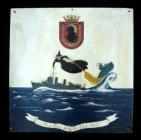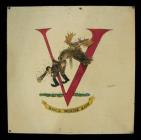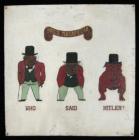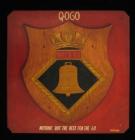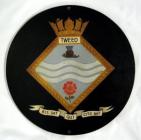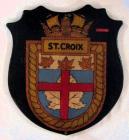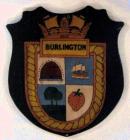1
The gunshields and badges on the Crow's Nest walls bear testament to the many naval ships which have visited the port of St. John's and the Nest since it opened in 1942. Of particular importance are the ones which were placed here during the Battle of the Atlantic (1939-1945). The brave young men, mostly in their early twenties, created colorful and sometimes fanciful art to represent their pride in their ships. The art was painted on the forward gun's protective shield in a manner similar to that of the nose art found on WWII military aircraft.According to Lynch and Lamb (1984), gunshield art originated on the South Side of St. John's Harbour in mid 1941 by the Royal Canadian Navy and Royal Navy ships in the Newfoundland Escort Force and eventually spread to other convoy escort groups based in St. John's. The practice reached its height in late 1942 (probably so the officers would have something to hang on the four square feet of Crow's Nest wall space allocated to each ship) and declined thereafter as modifications to the forward gunshields left little suitable space for artwork and routine maintenance caused existing art to be painted over. Then again, perhaps it was the loss of "the folly of youth" by crews prematurely aged by the harsh North Atlantic and the reputations gained in battles against a relentless foe that gave the ships a new identity which somehow made the previous artistic individuality unnecessary and the practice like other fads, faded away.
2
HMS Witch depicts a witch with her broom in one hand sweeping a U-boat from the seas while holding the top of the mast with her other hand. This portrays a continuing naval custom dating from the first Anglo-Dutch war of the mid 1600's when the Dutch Admiral Maarten Tromp tied a broom to his masthead to show his intention to sweep the British from the seas.4
Here a snorting moose with a U-Boat in its antlers is chasing down a fleeing Hitler. HMCS Moosejaw did indeed ram a U-Boat on its very first run as part of the Newfoundland Escort Force.5
Gunshield on HMCS MoosejawCirca 1941
St. John's, Newfoundland, Canada
 Credits:
Credits:Herbert Roberts Collection
2007-2008 Album, Crow's Nest
6
A large moose has his jaws wrapped around a protesting Hitler. The ever popular V-for-Victory is very pronounced. There is a story that the Canadian Navy's famous drink Moose Milk, was originally concocted aboard this corvette but its origins can be traced back to at least the 1700's. No matter the origin it's a great naval tradition.8
Herb Roberts on Matapedia Gun Platform with GunshieldCirca 1942
St. John's Harbour, Newfoundland
 Credits:
Credits:Herbert Roberts Collection
